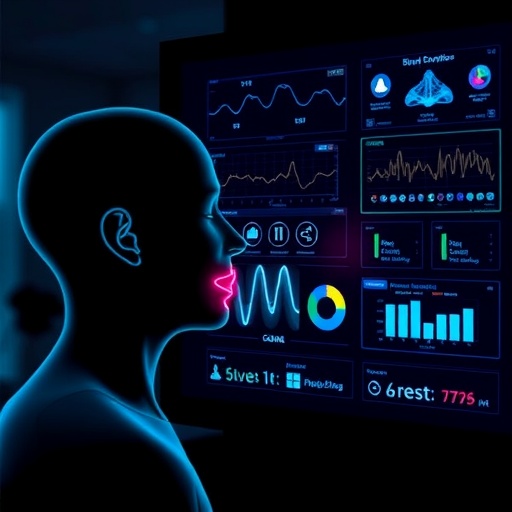In the quest for advancing wearable health technologies, researchers at North Carolina State University have taken a significant leap forward in the precise detection of coughs using wearable devices. Coughing, a critical biomarker, signals a variety of respiratory conditions and holds valuable insights for chronic health management. However, until now, the accuracy of devices in distinguishing coughs from other sounds, especially speech and nonverbal human noises, has remained a persistent challenge. This breakthrough promises to enhance the monitoring and predictive capabilities of wearable devices, particularly for asthma and other chronic respiratory diseases.
Coughing is more than just a nuisance; it serves as a vital indicator of health. Monitoring cough frequency can provide early warnings about the exacerbation of respiratory diseases and help in timely interventions, such as the use of inhalers in asthma patients. Edgar Lobaton, a professor of electrical and computer engineering and the lead author of the study, emphasizes cough detection’s potential to transform patient care by offering real-time health insights through continuous monitoring using wearable technology.
Wearable health devices capture data in real-world environments that are complex and noisy, posing a significant challenge for cough-detection algorithms. While prior machine learning models have been trained to identify cough sounds, they often falter when confronted with everyday noises that mimic coughing, such as sneezing, throat clearing, or even the sounds of speech. This limitation largely stems from models encountering unfamiliar sounds — sounds they were not exposed to during initial training phases.
To overcome this, Lobaton and his team devised an innovative approach involving multimodal data inputs collected from chest-worn wearable monitors. These devices gather not only audio signals but also accelerometer data that registers subtle chest movements associated with coughing. The synergy of sound data with motion data offers a richer, more nuanced understanding of cough events, as movement patterns serve as corroborative evidence supporting the acoustic signals.
While movement tracking alone is insufficient due to overlaps with non-cough actions like laughing or groaning, combining it with audio input significantly sharpens detection accuracy. Yuhan Chen, the study’s first author, elaborates that this integrated data fusion approach empowers the model to distinguish cough events with higher confidence. It reduces false alarms—instances where the device mistakenly identifies non-cough sounds as coughs—thus improving reliability.
Building upon previous machine learning advancements, the researchers refined their algorithms to optimize what they term “out-of-distribution detection.” This refers to the model’s enhanced ability to recognize when it encounters unfamiliar sounds and adjust its confidence level accordingly, reducing erroneous cough classifications. Their approach marks a pivotal advancement in wearable biosensing, allowing devices to better generalize across the diverse acoustic environments they experience in daily life.
When subjected to rigorous laboratory testing, the new multimodal cough detection model outperformed existing technologies with a measurable reduction in false positives. This improvement indicates the model’s proficiency in accurately filtering out speech and other nonverbal sounds that historically plagued cough-detection efforts. Such robustness is essential for clinical applications where high specificity and sensitivity directly impact patient health management decisions.
This enhanced cough detection capability opens up transformative possibilities for continuous health monitoring. Wearable devices equipped with these refined models can more effectively track the progression of respiratory diseases, aiding both patients and healthcare providers in managing conditions proactively. The technology’s potential extends to predicting acute health events, such as asthma attacks, enabling timely interventions that could prevent hospitalizations.
The team’s work dovetails with broader efforts to integrate artificial intelligence into personalized medicine, using real-time sensory data to paint a clearer picture of patient health. As wearable health technologies mature, innovations like this multimodal model will be foundational in delivering actionable health insights outside clinical settings, empowering individuals to take charge of their respiratory health.
Despite this progress, the researchers acknowledge ongoing challenges. Future work aims to enhance detection capabilities further, particularly in distinguishing coughs amidst even more variable sounds and environments. There is a clear trajectory toward refining sensor technology, algorithm robustness, and real-world deployment, making cough detection a dependable tool in the health-monitoring arsenal.
This research was supported by the National Science Foundation and NC State’s Center for Advanced Self-Powered Systems of Integrated Sensors and Technologies (ASSIST), underscoring the critical role of interdisciplinary collaboration in advancing wearable biosensor technologies. The study titled “Robust Multimodal Cough Detection with Optimized Out-of-Distribution Detection for Wearables” was published in the IEEE Journal of Biomedical and Health Informatics, offering a landmark reference point for future developments in this area.
In conclusion, the integration of multimodal data from wearable devices marks a vital advancement in cough detection technology. By harnessing both audio and motion inputs and optimizing algorithmic responses to new sound environments, this research paves the way for more reliable, real-world health monitoring solutions that could revolutionize respiratory disease management and chronic care.
Subject of Research: People
Article Title: Robust Multimodal Cough Detection with Optimized Out-of-Distribution Detection for Wearables
News Publication Date: 2-Oct-2025
Web References: IEEE Journal of Biomedical and Health Informatics DOI
Image Credits: Edgar Lobaton, NC State University
Keywords: cough detection, wearable devices, respiratory health, machine learning, multimodal data, accelerometer, audio processing, chronic disease monitoring, asthma prediction, biosensors, artificial intelligence, health technology




